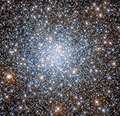Файл:NGC6638 - HST - Potw2231a.jpg

Барам хьажале: 622 × 599 пиксель. Кхин шоралла: 249 × 240 пиксель | 498 × 480 пиксель | 797 × 768 пиксель | 1063 × 1024 пиксель | 2125 × 2048 пиксель | 2611 × 2516 пиксель.
Оригиналан файл (2611 × 2516 пиксель, файлан барам: 3,35 Мб, MIME-тайп: image/jpeg)
Файлан истори
Тlетаlаде терахь/хан, муха хилла хьажарна и файл.
| Терахь/Хан | Жима | Файлан барам | Декъашхо | Билгалдаккхар | |
|---|---|---|---|---|---|
| карара | 2022, 1 август, 19:53 |  | 2611 × 2516 (3,35 Мб) | Fabian RRRR | == {{int:filedesc}} == {{Information |description={{en|1='''Star-Studded Skyfield This star-studded image from the NASA/ESA Hubble Space Telescope shows the heart of the globular cluster NGC 6638 in the constellation Sagittarius. The star-strewn observation highlights the density of stars at the heart of globular clusters, which are stable, tightly bound clusters of tens of thousands to millions of stars. To capture the data in this image, Hubble used two of its cutting-edge astronomical in... |
Файл лелор
ХӀара файл лахарчу 1 агӀонгахь лелош йу:
Глобалан файл лелор
ХӀара файл лелош йу лахахь гайтина йолу википедеш чохь:
- Лелор ar.wikipedia.org
- Лелор de.wikipedia.org
- Лелор diq.wikipedia.org
- Лелор en.wikipedia.org
- Лелор eo.wikipedia.org
- Лелор es.wikipedia.org
- Лелор eu.wikipedia.org
- Лелор fr.wikipedia.org
- Лелор nl.wikipedia.org
- Лелор tt.wikipedia.org
- Лелор www.wikidata.org


